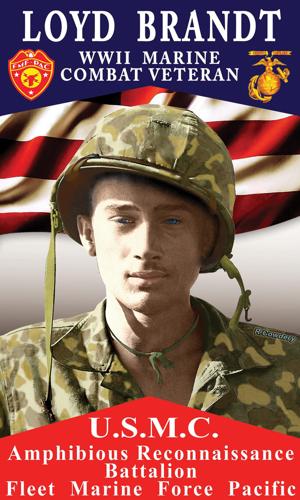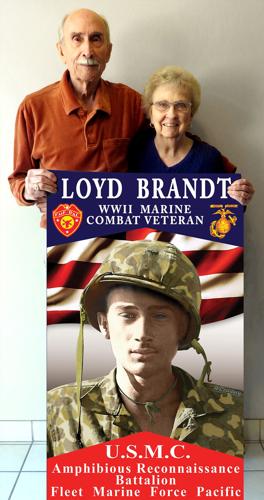The pleasure of spending a few hours with 99-year-old Loyd Brandt and Joyce, his wife of 78 years, is also splendid food for thought. How times have changed.
One of 10 South ∑¨«—app children in his family, Loyd was one of the seven Brandt boys, six of whom served in the United States Marine Corps in the Pacific during World War II. While many 17-year-olds today seem to have difficulty taking their eyes off their phones, Loyd and his twin brother Lester were just that age when they joined the Marine Corps in May 1943.
Loyd was no ordinary Marine rifleman; he went to war as a member of the Amphibious Reconnaissance Battalion of the Fleet Marine Force. Organized long before the OSS, Spec Ops and long before Green Berets, Loyd was in the original Marine Reconnaissance units used in the Pacific. As the youngest man in his outfit and the only one from South ∑¨«—app, he went on to make over 55 landings from submarines and inflatable rubber boats, never knowing what would greet him in the darkness as his outfit sneaked stealthily ashore into the backyard of the enemy.
People are also reading…
Their task was to gather intelligence and provide it for planned large-scale invasions set to take place, often within hours. On some occasions the recon units were used as assault or regular line Marines, fighting their way across dozens of small islands that had to be cleared of the enemy. There were many days when sleep or rest were concepts that were unattainable. The timetable for recon missions had been determined by the overall commander of the assault forces and they had to keep to that schedule.
Loyd served from February of 1944 through April of 1945 in the Pacific Theater of Operations, from the invasion of the Japanese occupied islands of the Eniwetok Atoll, to Saipan, to Tinian and Iwo Jima, and even the Japanese home island of Okinawa. He and his fellow Marines often found themselves withdrawing for rest and recuperation on the very islands that they had fought for only days or weeks before. He was a very active part of a great deal of the history of the entire WW2 Pacific campaign.
Loyd and his twin brother Lester survived, as did Harry, Luverne and Kenneth Brandt. Sadly, brother Herbert, eight years older and a father figure to Loyd, died on the island of Saipan on July 4, 1944.
After his return to South ∑¨«—app and Joyce‚Äôs graduation from high school, Loyd and Joyce married. In 1951 they moved to California with their two young children, Deanna and Doug, and Loyd worked as a lineman for the power company. In 1972, the couple and their son Doug, who served in the US Army in Vietnam in 1970 and 1971, returned to the Black Hills where Loyd switched careers and became an electrician at South ∑¨«—app School of Mines.
Like so many combat veterans, Loyd Brandt rarely talked about his remarkable but physically and emotionally exhausting experiences, and the sacrifices he made before he was even 20 years old. After he retired, demons came to the surface, and he sought help for what today is called PTSD.
We first met Loyd decades ago at a meeting of The Black Hills Veterans Writing Group organized by Brad Morgan and Dean Muehlberg to encourage veterans to record the history of their service. When Bill Casper, another member of that group, started the Veteran Banner project in 2017 we decided immediately that we wanted to sponsor and honor South ∑¨«—app‚Äôs remarkable Loyd Brandt, his service and his family. Loyd is the sole surviving brother in his family.


















